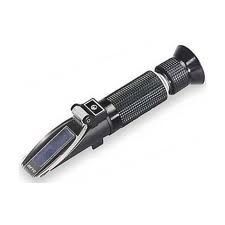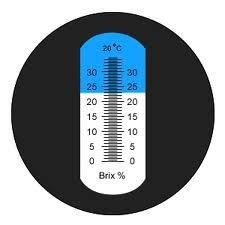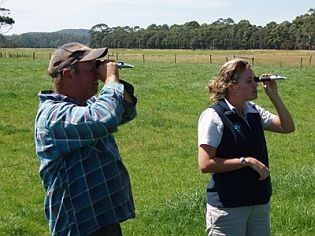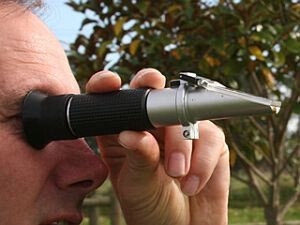Brix and nutrient dense food FAQ's
by Roger Martyn
What is Brix?
Brix, more correctly named 'degree Brix' (°Bx), named after the named after the 19th century Austrian scientist Adolf Brix who came up with the scale is a measure of the weight of sugar dissolved in water as percentage by weight (% w/w). Therefore a 5% brix solution is 5 grams of sugar dissolved in 95 grams of pure water at 25° Celsius and pure water would have a brix of 0%. mo
How is brix measured?
Brix can be measured a couple of ways. It can be measured with a hydrometer -an instrument used to measures the specific gravity of liquids- and which Adolf Brix used to develop the Brix scale, or more commonly, with an optical refractometer, an instrument that measures how much light is 'bent' when travelling through different types of liquid. There are also electronic brix meters which provide digital readouts and these too utilize the refractive properties of liquids to produce their readings.

What is Brix?
Brix, more correctly named 'degree Brix' (°Bx), named after the named after the 19th century Austrian scientist Adolf Brix who came up with the scale is a measure of the weight of sugar dissolved in water as percentage by weight (% w/w). Therefore a 5% brix solution is 5 grams of sugar dissolved in 95 grams of pure water at 25° Celsius and pure water would have a brix of 0%. more
How is brix measured?
Brix can be measured a couple of ways. It can be measured with a hydrometer -an instrument used to measures the specific gravity of liquids- and which Adolf Brix used to develop the Brix scale, or more commonly, with an optical refractometer, an instrument that measures how much light is 'bent' when travelling through different types of liquid. There are also electronic brix meters which provide digital readouts and these too utilize the refractive properties of liquids to produce their readings.

How does an optical refractometer actually work?
Light travels at different speeds in different media. The denser the medium is, the slower the speed. When light travels passes from one medium to the other, eg from air to water, it also changes direction. This is why for example, a fishing line dangling in water appears to change direction exactly at the point where it enters the water. Brix readings are simply the measurement of this change of direction as observed where a drop of liquid is placed on a glass prism housed within the optical brix meter. By looking through a view finder of the optical brix meter, just as you would look through a telescope, this can be observed as a distinct line above which there is also a change in colour. This demarcation line lowers or raises with liquids of lower or higher brix values and these can be read off against a scale which is also observable through the viewfinder. (see diagram)
How are brix readings used in agriculture?
Brix readings are routinely used in fruit growing to indicate when fruit is ripe enough to harvest. Brix is also used in wine and beer production to monitor the fermentation process that occurs when sugars are converted to alcohol. Brix is also used in the honey bee industry to monitor honey quality.
Brix is used to measure the suitability of dairy cow colostrum milk for feeding to calves.
Of more recent years, brix is increasingly being used as a 'quality' measure for forages, vegetables and fruits particularly by those involved in the biological, nutrient dense, organic, and biodynamic a forms of agricultural . Collectively they are often referred to as the Brix Movement.

What /Who are the Brix Movement?
The Brix Movement use brix readings as a means of ascertaining the quality of forages, vegetables and fruits. In general, the higher the brix reading, the better the quality. Many in the Brix Movement question the quality of today's food being produced by conventional farming methods where in order to grow produce that is blemish free and visually appealing to the consumer, make use considerable quantities of pesticides and high growth enhancing fertilisers. Too often though, such produce is lacking in taste and has poor handling, storage and keeping qualities. It is also likely to be of questionable nutritional benefit due to the likely low concentrations and even complete absence of many minerals and trace elements. (The mineral content of produce has declined markedly over the last 70 or so years. -see CSIRO data below. This and similar observation have been well documented in the US, UK, India, and Australia - also see below).
It is pretty much impossible to determine such factors simply by looking at produce. Tasting may provide some indications but only a laboratory analysis for minerals and and trace elements will confirm suspicions and this can is e xpensive and time consuming. However those of the Brix Movement claim that brix readings of plant juices as taken by a standard optical refractometer can be a good indicator of fruit and vegetable quality thus providing a very quick and cheap means of testing for food quality. Generally, the higher the reading, the better the produce. This is based on brix work carried out by Dr Carey Reams (1903-1985). Those within the Brix Movement seek to grow nutrient dense food.
What are the claimed characteristics of high brix crops?
Improved taste, improved keeping quality, greater insect, viral, bacterial and fungi attack resistance, firmer (as measured with a penetrometer) and better handling characteristics, enhanced frost protection.
How do I grow high brix crops?
Soil test for elements AND microbial activity and interpret using a Albrecht or Reams approach. Apply balanced fertilisers that include minor and trace elements, - broad spectrum if necessary. Look after and monitor soil microbial life and apply soil innoculants. Monitor crops with brix; foliar spray with nutrients as necessary to maintain/improve brix. Consensus of practitioners claim microbial activity is the key. Both Reams and Albrecht emphasized microbial activity is essential for good soil fertility.
Does organic food have higher brix than non organic?
While organic food is likely to be free of pesticide residue (and therefore potentially better for you), unless soils contain the required amounts, presence and required balance of minerals including minor and trace elements, and good microbial activity, they are unlikely to differ from non organic.
What about biodynamic?
The same comments comparing organic brix levels to non organic equally apply to biodynamically grown food.
Can brix be used to measure animal products such as meat and milk?
It appears brix is used mostly to measure the juices of plants. Some claim to use brix to measure milk. Brix is routinely used to measure the quality /suitability of milk colostrum for feeding to calves.
Are there standards for brix?
No, there do not appear to be any brix standards per-se. There are only those guidelines that originated from Reams's work and those of modifications of Reams's guidelines by others.
A good question to ask yourself is what standards alternatives are there? Some argue that ANYTHING is better than what currently defines food standards.
Is brix too simplistic a measure?
Brix measurement is but a tool and since brix measures total dissolved solids which may or may not include the desirable minerals, sugars, proteins etc that food of good quality have, then it can be argued that brix is indeed too a too simplistic a measure. Battery acid for example will raise brix. However, there is a very strong consensus amongst those advocating and using brix meters for growing quality food that if brix as a tool is used in conjunction with practices that address soil fertility and microbial activity as outlined above, then as a tool for indicating the likely quality, health and well being of the soil and food being grown, then a brix instrument might be the only monitoring tool you essentially need to use.
I find my that while my brix readings are reasonably good, I fail to get a clear defined readings when looking through the view finder. They always look cloudy and out of focus Why is this?
This is apparently a function of what constitutes the dissolved solids being measured. Often for example a high calcium content for example will result in a 'cloudy' reading whereas distilled water shows a clearly defined line. Some claim that the cloudiness indicates a range of minerals are present, and/or complex protein are present whereas a simple sugar-only presence would show a much clearer line. In general the cloudiness described is considered to a desirable attribute and in practice it is not too difficult to ascertain readings.


